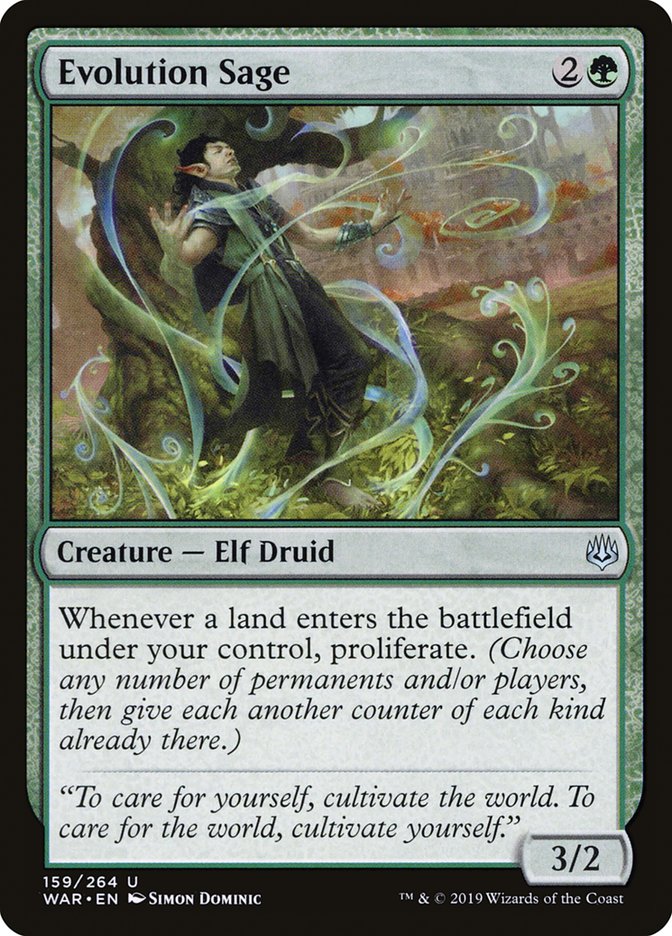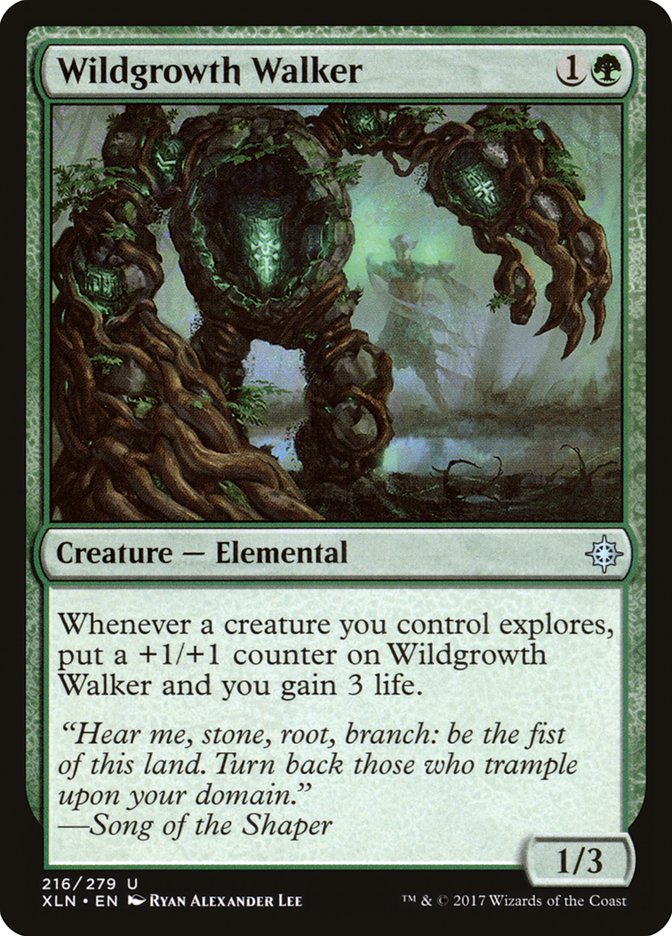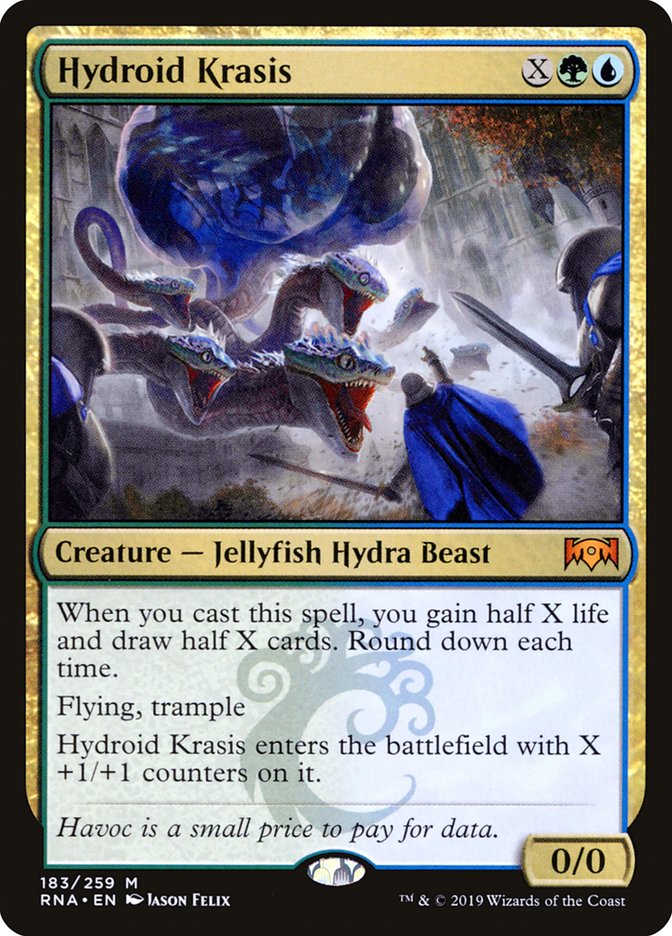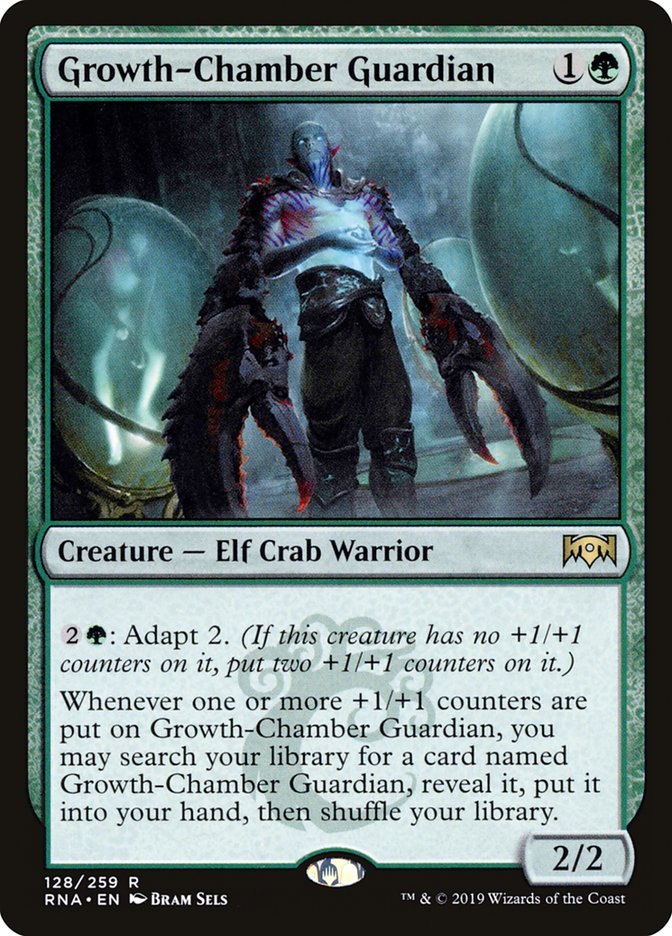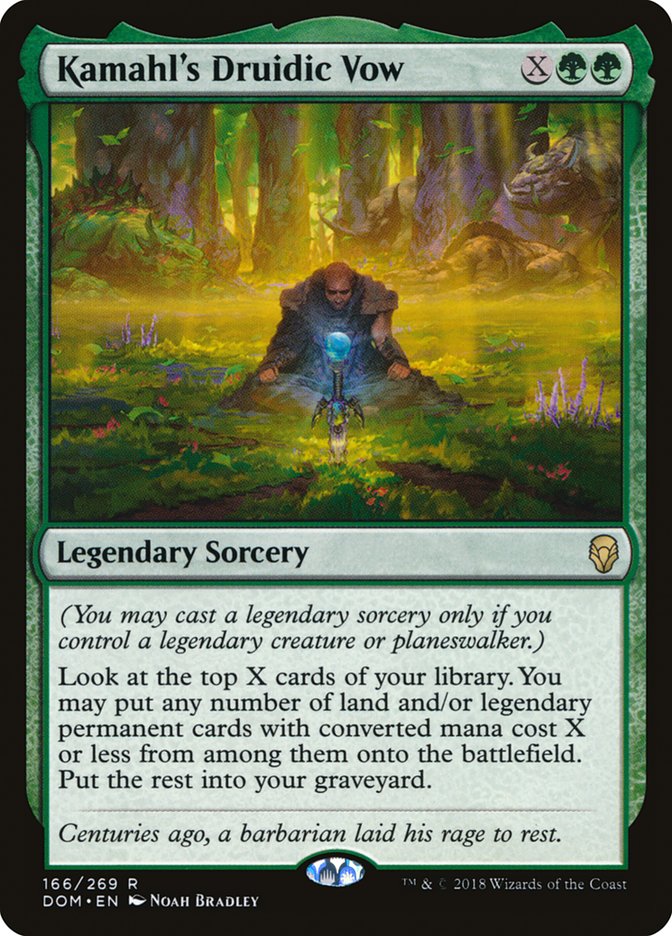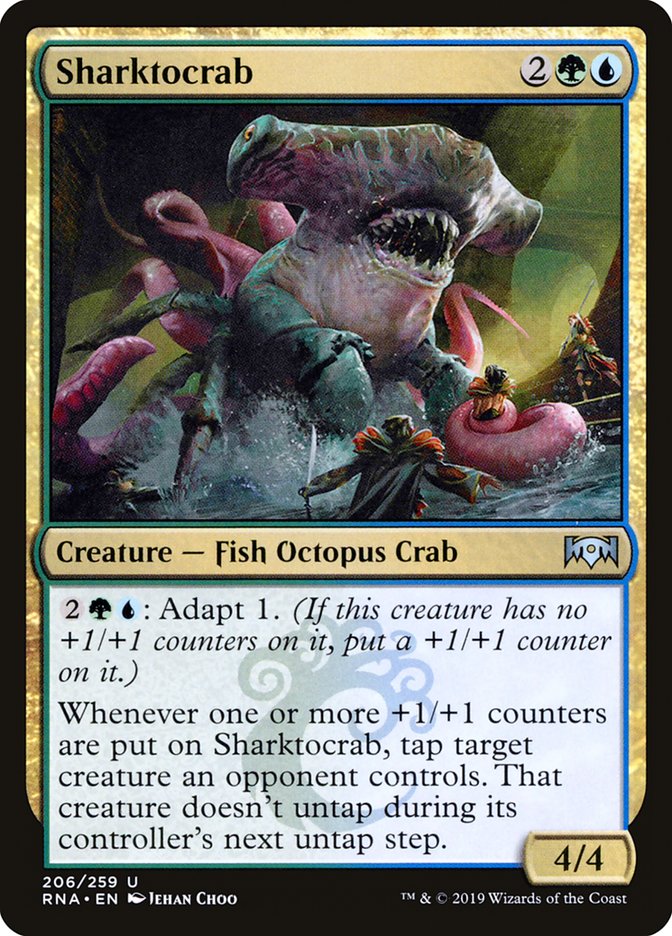Evolution Sage is shockingly easy to use and works with almost anything. At first pass, I want to compare it to Tireless Tracker. The similarities are obvious – it’s a 3/2 for 2G that has a trigger when a land enters the battlefield under your control – but I don’t think that comparison is really fair to either of them. Let’s contrast them instead:
While Tireless Tracker existed in a set where it could have synergies with other cards that interacted with Clues, in practice that was never the point in Constructed. Tireless Tracker required basically no assistance. Just play lands and it will help you do more of whatever your deck does. As a result, it was a great sideboard card in almost every deck and a solid maindeck card in most interactive green decks.
While any deck can meet the condition to trigger Evolution Sage, the value of proliferating is much more fluid than the value of making a Clue. If all you have are lands and Evolution Sage, it might as well be a Gorilla Warrior, but on the right battlefield, it can have an immediate impact that greatly exceeds the future value of drawing a card someday.
Is Evolution Sage better than Tireless Tracker? The answer is both “no” and “this question misses the point.” Evolution Sage is a card you want to build around, and a card you probably want to cast later in the game in most circumstances, after you’ve had a chance to generate the kind of battlefield where it can really shine.
So how do we do that? What kinds of decks take advantage of Evolution Sage? Fortunately, there’s no shortage of cards or decks, even from among decks that already exist, that could benefit from Evolution Sage.
In Standard, you’re generally looking for decks with +1/+1 counters and decks with planeswalkers. Take, for example, Sultai Midrange.
Wildgrowth Walker, Merfolk Branchwalker, Jadelight Ranger, Hydroid Krasis, and Growth-Chamber Guardian or Incubation Druid can all give themselves +1/+1 counters and these decks typically play several planeswalkers. Adding counters to Vivien Reid stands out as particularly powerful to me, since the ultimate is so good, and it feels like adding extra counters will change whether you get to reach the ultimate in a given game more often than it will with Vraska’s because they have +2 abilities and Vivien only has +1.
Merfolk as a tribe will often end up with more creatures on the battlefield that have +1/+1 counters, but I think the cost to putting an Elf Druid into that deck is much greater than the cost of putting it in a Sultai Midrange deck, so I expect Sultai Midrange to be the best home for Evolution Sage from the current Standard decks that exist.
But of course we’re not limited to Standard decks that already exist. We have a host of new planeswalkers to work with and no shortage of cards that work particularly well with proliferate.
Creatures (26)
- 4 Llanowar Elves
- 2 Shalai, Voice of Plenty
- 2 Venerated Loxodon
- 2 Trostani Discordant
- 4 Chamber Sentry
- 4 Growth-Chamber Guardian
- 4 Incubation Druid
- 4 Evolution Sage
Planeswalkers (9)
- 1 Vivien Reid
- 1 Ajani, Adversary of Tyrants
- 2 Ajani, the Greathearted
- 2 Teyo, the Shieldmage
- 1 Vivien, Champion of the Wilds
- 2 Jiang Yanggu, Wildcrafter
Lands (21)

I’m really curious about Chamber Sentry in this kind of deck. In the past, I haven’t been impressed by the card in Standard because it’s so expensive to use, but my thinking is that with proliferate and Jiang Yanggu, Wildcrafter, I’m pretty happy with a one-mana 0/0 with a +1/+1 counter. A lot of the time, I’ll cast it as a 2/2 instead, and in the mid- to late-game, the ability to shoot things might be pretty valuable, especially with so many ways to generate extra mana and additional counters. I suspect this is a card to keep in mind in any deck in Standard that’s trying to proliferate.
Teyo, the Shieldmage looks like a pretty weak card to me until I start thinking about adding counters to the 0/3 creatures and making more of them thanks to adding counters to Teyo. Then I actually start to get pretty excited about Teyo
Jiang Yanggu, Wildcrafter enables some pretty explosive starts, the best case being:
- Turn 1 Llanowar Elves
- Turn 2 Incubation Druid, Chamber Sentry with X=1
- Turn 3 Jiang Yanggu, -1, counter on Incubation Druid
At this point you have five additional mana to spend on Turn 3.
Planeswalkers get a lot better when you have multiples on the battlefield because it’s so much harder for your opponent to answer them all in combat and every turn you pull much further ahead. I’m interested in how much we can push that by adding another color.
Creatures (16)
- 4 Llanowar Elves
- 1 Emmara, Soul of the Accord
- 2 Incubation Druid
- 4 Paradise Druid
- 2 Fblthp, the Lost
- 3 Evolution Sage
Planeswalkers (15)
- 2 Teferi, Hero of Dominaria
- 2 Vivien Reid
- 1 Ajani, Adversary of Tyrants
- 3 Dovin, Grand Arbiter
- 2 Ajani, the Greathearted
- 3 Teferi, Time Raveler
- 1 Teyo, the Shieldmage
- 1 Kasmina, Enigmatic Mentor
Lands (22)
Spells (6)

This deck is probably a little tricky to parse. Planeswalkers are complicated and it’s easy to get lost in a sea of them as far as imagining what this deck actually does. The key points here:
- Llanowar Elves is usually not great at enabling Azorious-based planeswalkers on Turn 2 since it costs green and taps for green, which means two of the three mana you have available on Turn 2 is green and so it’s hard get 1UW. That doesn’t apply here. Not only are there only three basic Forests and eight shocklands that can cast Llanowar Elves on Turn 1 while giving blue or white mana on Turn 2, but this deck plays four copies of Interplanar Beacon, which allows you to cast Dovin, Grand Arbiter on Turn 2 even if you played a Forest and a Llanowar Elves on Turn 1, which means this deck is very good at casting a planeswalker on Turn 2.
- Teferi, Time Raveler is a nightmare for control decks, as it means they can’t counter any of your other spells.
- The other three and four-mana planeswalkers either make creatures or put counters on creatures. These help to defend your planeswalkers and ultimately overwhelm your opponent.
- There are 44 cards in the deck that Kamahl’s Druidic Vow puts onto the battlefield. Even if X is only four, there are still 40 hits. That means if X is four, you’ll get two or more permanents 90% of the time, three or more over 60% of the time, and the full four 20% of the time. If X is five, you’ll get at least three permanents 90% of the time and four or five over 60% of the time. That may sound like a lot of mana, but this deck has 35 mana sources and only 22 of them are lands, which means that, if your opponent doesn’t kill your mana creatures, you should be able to cast Kamahl’s Druidic Vow for five on Turn 5 around a third of the time.
Where Kamahl’s Druidic Vow gets really exciting (outside of when you get to draw two cards off Fblthp, the Lost) is when you have Evolution Sage on the battlefield, as you’ll then proliferate onto all the planeswalkers you already had and all the new ones you hit for every land you hit.
- I’ve included Evolving Wilds in both decks for the extra trigger for Evolution Sage. I’m not entirely sure whether that’s worth it but my instinct is that it is in small numbers. It’s frustrating that it’s hard to play more Karn’s Bastions or Mobilized Districts, as both cards would be excellent here, but I’m worried about the colorless mana and I think it’s more important to cast all my spells.
The last Standard deck I want to look at is a Simic deck that looks to take advantage of proliferating onto Sharktocrab, among other things:
Creatures (30)
- 4 Llanowar Elves
- 4 Jadelight Ranger
- 1 Dream Eater
- 1 Chamber Sentry
- 1 Zegana, Utopian Speaker
- 1 Prime Speaker Vannifar
- 3 Sharktocrab
- 4 Incubation Druid
- 3 Fblthp, the Lost
- 3 Merfolk Skydiver
- 2 Roalesk, Apex Hybrid
- 3 Evolution Sage
Lands (23)
Spells (7)
Sideboard

This deck makes great use of Neoform. You can sacrifice Fblthp, the Lost to get Evolution Sage before playing a land on Turn 3 and then play a land and immediately proliferate to get a 5/4 Evolution Sage. Or you can sacrifice a Jadelight Ranger to get Sharktocrab with a counter to immediately freeze something and then you can add more counters to it with Evolution Sage, Merfolk Skydiver entering the battlefield or proliferating, Hadana’s Climb, or Roalesk, Apex Hybrid entering the battlefield or dying.
While all the cards work together, it’s basically a straightforward Hadana’s Climb aggro deck with a small Prime Speaker Vannifar package that uses Neoform well but mostly looks to beat other creature decks with Sharktocrab.
While there are exciting possibilities for Evolution Sage in Standard, things get even better in formats with fetchlands and more counters. The most obvious home is in Hardened Scales, since that deck already uses the proliferate mechanic, but I have concerns about the number of lands and that deck’s ability to use fetchlands to optimize Evolution Sage given how strong the existing lands are.
My favorite thing to proliferate onto in Modern is Everflowing Chalice, and Turn 2 Everflowing Chalice into Turn 3 Evolution Sage, fetchland, activate is a nice curve, but it’s hard to figure out what the rest of that deck looks like. What are you doing with all that mana? Is this a package that the existing Tooth and Nail decks can include? Are we looking at Doubling Season and planeswalkers?
The other question is whether you want to focus on proliferating onto many things by filling the battlefield with permanents with counters on them or whether you want to focus on proliferating many times by putting extra lands on the battlefield.
I suspect you want to focus on maximizing payoff upfront and minimizing the total amount of mana required to establish a battlefield that will give you a large advantage from proliferating, as doing anything else seems like it’s just trying to win more and will generally lead to something too slow, fragile, and flashy for Modern.
Honestly, I expect this card to be a miss for Modern. However, there’s a popular format with fetchlands and countless cards you can play that use counters where winning more and doing slow, flashy things is precisely the goal. That format, of course, is Commander, where I expect Evolution Sage to be a perennial all-star, which, if I understand anything about the Commander market and Magic finance (spoiler: I don’t), means you should probably invest in foils as soon as possible.
All told, I know there’s a lot of hype for Evolution Sage and my expectation is that it won’t see substantial success in Modern but it has a chance in Standard, although there’s the possibility that it ultimately needs too much to go right. Regardless of its tournament success, I expect it to remain one of the most popular cards in the set due to its fantastic application in casual formats, especially Commander.


